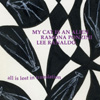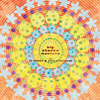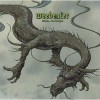 "Beach Fervour Spare" is the second installment of the deep bass journey begun last year with "Deep Space". This time around the band is minus Bill Laswell and Jaki Leibeziet and plus Mark Sanders - drums, Chris Cookson - guitar and production, Paul Schütze - atmospheres and Marc Angelo Lusardi - production and retains Clive Bell and Jean Pierre Rasle. I don't (yet) have the first album so I can't compare the two cds and bands, but there's no doubt that this unit has played together for some time.
"Beach Fervour Spare" is the second installment of the deep bass journey begun last year with "Deep Space". This time around the band is minus Bill Laswell and Jaki Leibeziet and plus Mark Sanders - drums, Chris Cookson - guitar and production, Paul Schütze - atmospheres and Marc Angelo Lusardi - production and retains Clive Bell and Jean Pierre Rasle. I don't (yet) have the first album so I can't compare the two cds and bands, but there's no doubt that this unit has played together for some time.
Two new shows just for you. We have squeezed out two extended release episodes for this weekend to get you through this week. They contain mostly new songs but there's also new issues from the vaults. The first show features music from Rider/Horse, Mint Field, Robert Aiki Aubrey Lowe, Anastasia Coope, ISAN, Stone Music, La Securite, Bark Psychosis, Jon Rose, Master Wilburn Burchette, Umberto, Wand, Tim Koh, Sun An, and Memory Drawings. The second episode has music by Laibach, Melt-Banana, Chuck Johnson, X, K. Yoshimatsu, Dorothy Carter, Pavel Milyakov, Violence Gratuite, Mark Templeton, Dummy, Endon, body / negative, Midwife, Alberto Boccardi, Divine. Cow in Maui from Veronika in Vienna. Get involved: subscribe, review, rate, share with your friends, send images! |



 Recorded six years ago, but just released this year, this is a three way collaboration with some of the biggest names who inhabit that gray space between musique concret and harsh noise. The result is an all-too-brief work that covers the strengths of both scenes quite nicely.
Recorded six years ago, but just released this year, this is a three way collaboration with some of the biggest names who inhabit that gray space between musique concret and harsh noise. The result is an all-too-brief work that covers the strengths of both scenes quite nicely. I have not heard anything from this French duo since 2008's The World Upside-Down, but their gently roiling and shimmering guitar drone made a big impression on me.  On this, their first full-length vinyl release, Pierre Faure and Thierry Monnier caught me a bit off-guard by taking a much more minimal and much less overtly musical approach.  It definitely took me a while to warm to these changes, as their new arsenal of buzzes, hums, and whirs does not offer much in the way of immediacy, melody, or rhythm. However, there is still quite a lot to like here, as Sun Stabbed have made some significant creative progress over the last few years– it just takes some faith and patience to appreciate it.
I have not heard anything from this French duo since 2008's The World Upside-Down, but their gently roiling and shimmering guitar drone made a big impression on me.  On this, their first full-length vinyl release, Pierre Faure and Thierry Monnier caught me a bit off-guard by taking a much more minimal and much less overtly musical approach.  It definitely took me a while to warm to these changes, as their new arsenal of buzzes, hums, and whirs does not offer much in the way of immediacy, melody, or rhythm. However, there is still quite a lot to like here, as Sun Stabbed have made some significant creative progress over the last few years– it just takes some faith and patience to appreciate it. Sonic Youth and the Opalio Brothers both share a definite propensity towards ambitious and fruitful international collaborations, so it was pretty much inevitable that they'd wind up occasionally intermingling.  In fact, this live Verona performance is actually the second time that these four musicians have shared a stage, having previously performed with Dead C's Michael Morley in 2008 as part of a French art exhibition.  In theory, the combination of Ranaldo's tumultuous guitar noise, Ponzini's Japanese percussion, and Roberto Opalio's weird sci-fi toys has the potential to be something quite spectacular.  The reality is a bit less than that, but this album definitely has its share of compelling moments.
Sonic Youth and the Opalio Brothers both share a definite propensity towards ambitious and fruitful international collaborations, so it was pretty much inevitable that they'd wind up occasionally intermingling.  In fact, this live Verona performance is actually the second time that these four musicians have shared a stage, having previously performed with Dead C's Michael Morley in 2008 as part of a French art exhibition.  In theory, the combination of Ranaldo's tumultuous guitar noise, Ponzini's Japanese percussion, and Roberto Opalio's weird sci-fi toys has the potential to be something quite spectacular.  The reality is a bit less than that, but this album definitely has its share of compelling moments. After recently loving the Sun Splitter cassette on Land of Decay, I had high hopes going into this split and they most certainly came through. Their half here stands up proudly with that tape, which is no easy feat, and the Bridesmaid side is no slouch either.
After recently loving the Sun Splitter cassette on Land of Decay, I had high hopes going into this split and they most certainly came through. Their half here stands up proudly with that tape, which is no easy feat, and the Bridesmaid side is no slouch either. In contrast to the way I felt about their last collaboration, Space Finale, Big Shadow Montana is a dynamic, ever changing composition that mixes random sounds, droning electronics, and even some actual, albeit odd, passages of music into a perfect soundtrack for a '60s exploitation flick that never existed.
In contrast to the way I felt about their last collaboration, Space Finale, Big Shadow Montana is a dynamic, ever changing composition that mixes random sounds, droning electronics, and even some actual, albeit odd, passages of music into a perfect soundtrack for a '60s exploitation flick that never existed. The guys in Weedeater don't have a use for virtuosic solos, blastbeats, tormented wails, or any of traditional heavy metal's idiosyncrasies. Frankly, they sound far too zoned out to care—or at least, I imagine they'd like us to think so, given an album title that winks at opiate use and the tar-black, sludgy riffs that coat their follow-up to 2007's God Luck and Good Speed.
The guys in Weedeater don't have a use for virtuosic solos, blastbeats, tormented wails, or any of traditional heavy metal's idiosyncrasies. Frankly, they sound far too zoned out to care—or at least, I imagine they'd like us to think so, given an album title that winks at opiate use and the tar-black, sludgy riffs that coat their follow-up to 2007's God Luck and Good Speed. The three movements of Untitled #360 stand out distinctly in Francisco López’s recent body of work, largely due to their sheer sense of force and chaos. With scant information as far as source material goes, my best guess is that he plundered sound effects libraries, especially those aimed at action and horror film productions, to construct this lengthy composition. Rather than radically processing these sources, he instead focuses on layering and arranging them (with tasteful amounts of treatment) to create a tense, audio-only pseudo-narrative that is among the most aggressive and harsh that I have heard from him.
The three movements of Untitled #360 stand out distinctly in Francisco López’s recent body of work, largely due to their sheer sense of force and chaos. With scant information as far as source material goes, my best guess is that he plundered sound effects libraries, especially those aimed at action and horror film productions, to construct this lengthy composition. Rather than radically processing these sources, he instead focuses on layering and arranging them (with tasteful amounts of treatment) to create a tense, audio-only pseudo-narrative that is among the most aggressive and harsh that I have heard from him. This second release from the recently reawakened Dead Can Dance is quite a delightful surprise, radically departing from its uneven predecessor and displaying a striking degree of creative reinvigoration. Rather than another stab at recreating classic DCD fare like Aion, Dionysus is a conceptually rich and structurally inventive plunge deep into the folklore and spirit of Dionysian rituals and festivals. An intriguing concept does not necessarily lead to an intriguing album, of course, but Dionysus finds Dead Can Dance at the peak of their instrumental powers, unfolding as feast of wonderfully vibrant rhythms, esoteric instrumentation, and inspired arrangements. It is quite a remarkable and improbable achievement, as it sounds very little like prime Dead Can Dance, yet absolutely feels like prime Dead Can Dance. If Dionysus had come out in the band’s golden age of the late '80s and early '90s, there would most certainly be a small but devoted contingent of fans that viewed it as dark horse contender for the duo's finest album.
This second release from the recently reawakened Dead Can Dance is quite a delightful surprise, radically departing from its uneven predecessor and displaying a striking degree of creative reinvigoration. Rather than another stab at recreating classic DCD fare like Aion, Dionysus is a conceptually rich and structurally inventive plunge deep into the folklore and spirit of Dionysian rituals and festivals. An intriguing concept does not necessarily lead to an intriguing album, of course, but Dionysus finds Dead Can Dance at the peak of their instrumental powers, unfolding as feast of wonderfully vibrant rhythms, esoteric instrumentation, and inspired arrangements. It is quite a remarkable and improbable achievement, as it sounds very little like prime Dead Can Dance, yet absolutely feels like prime Dead Can Dance. If Dionysus had come out in the band’s golden age of the late '80s and early '90s, there would most certainly be a small but devoted contingent of fans that viewed it as dark horse contender for the duo's finest album.
